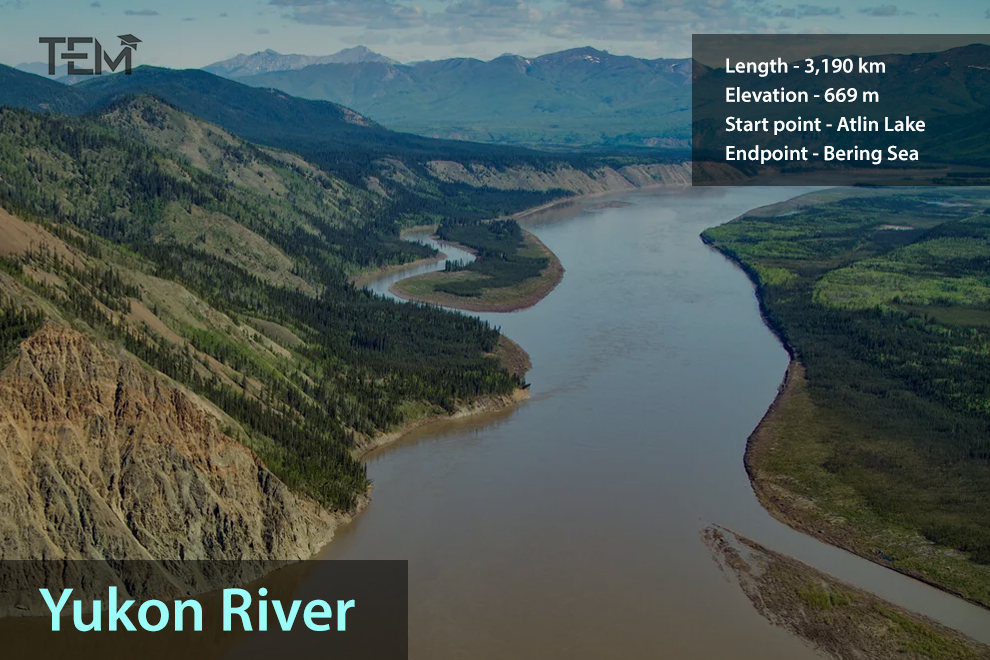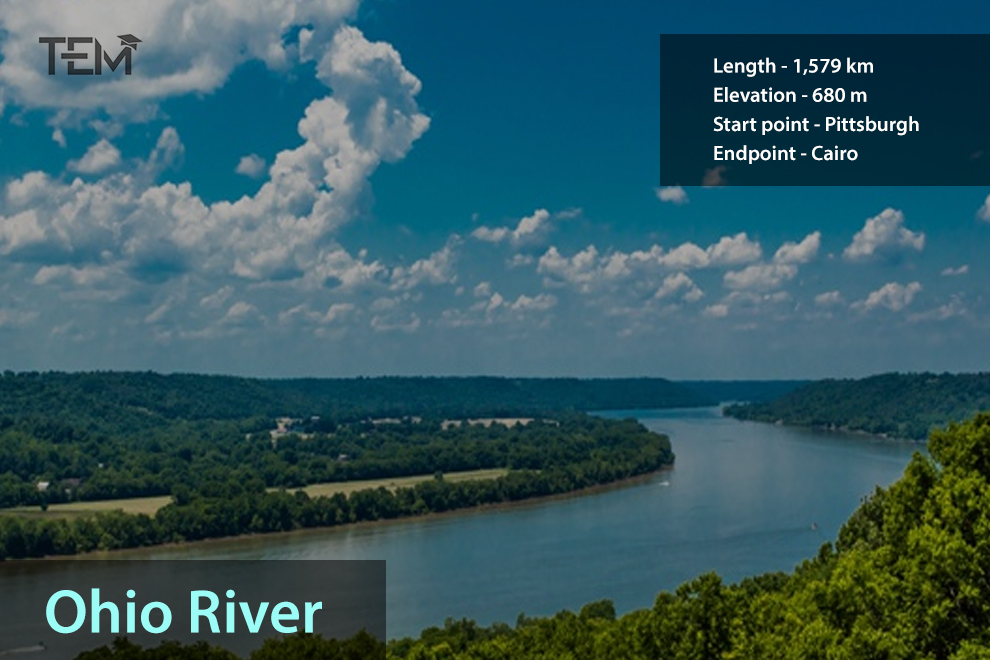The United States is home to a vast expanse of water, spanning a staggering 264,837 square miles, constituting approximately 7% of the country’s total area of 3,796,742 square miles. Within this extensive aquatic landscape, the nation boasts some of the longest rivers in the world. These mighty waterways carve through diverse terrains, impacting the surrounding ecosystems and serving as vital sources of water, transportation, and recreation. This blog will explore the extraordinary length and significance of the longest rivers in the USA, shedding light on these natural wonders’ unique characteristics and contributions.
1. Missouri River

- Length – 3,768 km
- Elevation– 2,800 m
- Start point – Rocky Mountains
- Endpoint – Mississippi River
The Indigenous Missouri tribe, known as the “People of the Big Canoe,” bestowed the name Missouri River upon the majestic waterway. It flows through seven states, encounters six dams, and is vital in the lives of those areas along its banks. Its expansive reach encompasses parts of ten U.S. states and stretches into two Canadian provinces, carving a path through sparsely populated regions. For more than 12,000 years, communities have relied upon the Missouri River and its tributaries, cherishing them as invaluable sources of sustenance and means of transportation. Discover the beauty and significance of one of the longest rivers in the USA, the Missouri River.
2. Mississippi River

- Length – 3,766 km
- Elevation – 450 m
- Start point – Lake Itasca
- Endpoint – Gulf of Mexico
The Mississippi River, known for being one of the longest rivers in the USA, is a hub of recreational activity and a vital ecosystem. Water-skiing was born on this beautiful river that runs through ten different states in the United States, connecting various communities and landscapes, making it a significant landmark. With an impressive 25% of all North American fish species calling it home, the Mississippi River showcases the diversity of aquatic life in the region. One fascinating fact about this iconic waterway is that it takes a staggering three months for the water to travel the entire length of the river, emphasizing its vastness and power.
3. Yukon River

- Length – 3,190 km
- Elevation – 669 m
- Start point – Atlin Lake
- Endpoint – Bering Sea
Yukon is derived from the Gwich’in language, meaning “great river.” This vast region was originally inhabited solely by North American Indians until the mid-19th century, including explorers from the expanding Russian Empire started to migrate into the area. During the Klondike Gold Rush of 1896-1903, it served as one of the primary routes for travel. A notable landmark on the Yukon River is the Whitehorse Fishway, located at the Whitehorse Dam, which is the world’s longest wooden fish ladder, measuring 366 meters (1,200 feet) in length.
4. Rio Grande

- Length – 3,034 km
- Elevation – 3,890 m
- Start point – San Juan Mountains
- Endpoint – Gulf of Mexico
In Mexico, the Rio Grande, also known as the Rio Bravo, earned its name due to its wild nature as the furious river. They have constructed fifteen dams along its path. This mighty river boasts over 100 tributaries, contributing to its significance and ecological impact. However, a concerning issue looms as the river gradually dries out, prompting multiple declarations of endangerment throughout its history. This unfortunate trend has dire consequences for the Rio Grande silvery minnow, a fish species that was once widespread but now faces the looming threat of extinction.
5. Colorado River

- Length – 2,334 km
- Elevation – 3,104 m
- Start point – La Poudre Pass
- Endpoint – Gulf of California
In 1539, Francisco de Ulloa, a European explorer, made the initial discovery of the Colorado River. This river system holds great significance as it provides water to approximately 40 million individuals residing in southwestern North America. Along its course, the Colorado River receives contributions from more than 25 significant tributaries, with the Green River being the largest in terms of length and discharge. The rivers and streams of the Colorado basin were home to 49 native fish species, with 42 of them being unique to this area.
6. Arkansas River

- Length – 2,364 km
- Elevation – 2,965 m
- Start point – Rocky Mountains
- Endpoint – Mississippi River
The Arkansas River, a significant Mississippi River tributary, has a rich history. In the 1540s, Hernando de Soto made a remarkable discovery when he encountered the junction of the Arkansas and Mississippi rivers. At that time, the Spanish referred to the river as Napeste. However, the name “Arkansas” was bestowed upon it by Father Jacques Marquette in 1673, who documented it as Akansa in his journal. Throughout the American Civil War, both sides sought to obstruct the use of the Arkansas River and its tributaries as strategic passages for transporting reinforcements.
7. Columbia River

- Length – 2,000 km
- Elevation – 820 m
- Start point – Columbia Lake
- Endpoint – Pacific Ocean
The Columbia River holds immense historical significance as humans have interacted with its ecosystem for thousands of years. Throughout history, this river has witnessed numerous interactions and developments. Additionally, the river system is nourished by over 60 significant tributaries, further enhancing its ecological importance. The main stem of the Columbia River boasts 14 dams, with 11 situated in the United States and 3 in Canada. Remarkably, it stands as the largest hydroelectric power-producing river in North America, hosting a total of fourteen hydroelectric dams along its course, benefiting both nations it passes through.
8. Red River

- Length – 2,189 km
- Elevation – 2,643 m
- Start point – Minnesota
- Endpoint – Mississippi River
The Red River, also known as the Red River of the South, holds significance as one of the longest rivers in the USA, especially a major river in the Southern United States. It derives its name from the red-bed country found within its watershed and stands as one among numerous rivers bearing the same name. In 1806, President Thomas Jefferson took the initiative to commission the Red River Expedition, a mission to explore regions of the newly acquired Louisiana Purchase by navigating the Red River. Notably, the Red River is intricately linked to the Mississippi River through the Old River Control Structure, reinforcing its importance in the region’s waterway network.
9. Snake River

- Length – 1,735 km
- Elevation – 2,806 m
- Start point – Rocky Mountains
- Endpoint – Washington Tri-Cities
The Snake River, the largest tributary of the Columbia River, meanders through diverse landscapes, accumulating over 20 major tributaries that predominantly originate from the majestic mountains within its basin. This expansive river system has witnessed the construction of fifteen dams, each serving a unique purpose and contributing to the multifaceted utilization of its resources. Historically, the Snake River played a vital role as a crucial spawning ground for anadromous fish, exemplifying its ecological significance and profound impact on the region’s biodiversity.
10. Ohio River

- Length – 1,579 km
- Elevation – 680 m
- Start point – Pittsburgh
- Endpoint – Cairo
The Ohio River, the largest tributary of the Mississippi River in the United States in terms of volume, has a rich history. It was first explored by the French explorer René-Robert Cavelier, Sieur de La Salle, in 1669. Initially a naturally shallow river, it underwent significant modifications by constructing several dams. In 1885, engineers constructed the first dam and lock, and they continued to build a comprehensive network of 46 locks and dams until 1929. These engineering endeavors deepened the Ohio River artificially, enhancing its navigability and transforming it into a vital waterway for transportation and commerce.
In conclusion, the longest rivers in the USA showcase the country’s diverse landscapes and play a vital role in its history and identity. These waterways, from the iconic Mississippi River to the majestic Colorado River, leave an indelible mark on the nation. Preserving and appreciating these rivers ensures their enduring legacy for future generations.
ALSO READ: 5 Longest Bridges in The World to take your Breath Away


